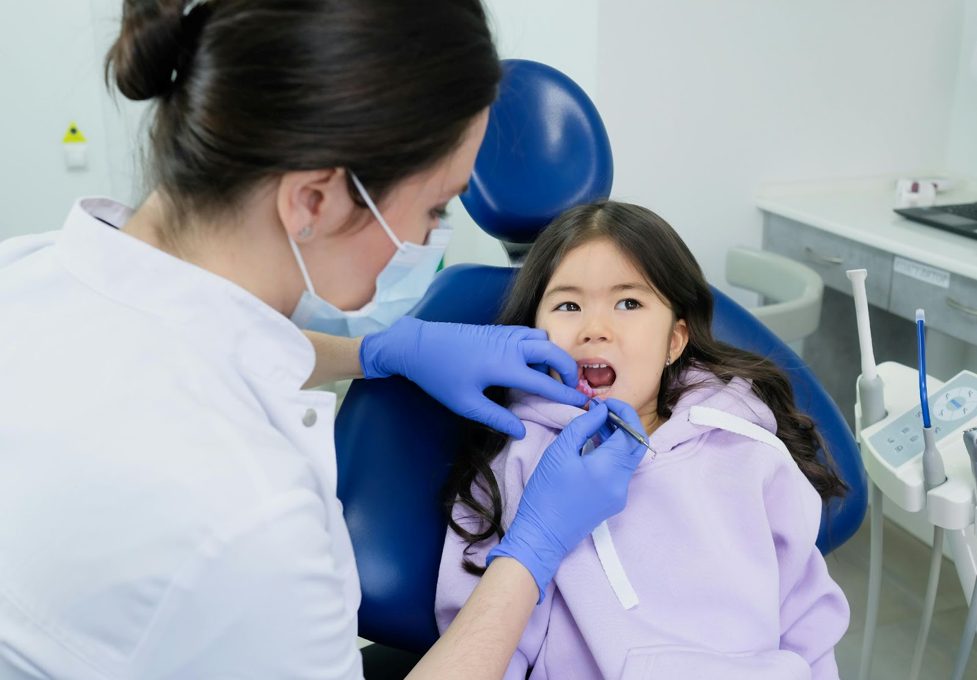
@ShahidNShah


Local pediatric dental specialists have mastered the art of turning dental visits into pleasant experiences for children. They understand that a child’s anxiety often stems from fear of the unknown or previous negative experiences. By creating vibrant, engaging environments and using language that children understand, these specialists help young patients feel at ease. They even involve parents in the process for added comfort. Discover how these experts transform apprehensive visits into enjoyable adventures.
Children often experience dental anxiety due to a combination of unfamiliar environments, fear of pain, and the intimidating appearance of dental tools. Emotional triggers can be sparked by past experiences or stories shared by others. Parental influence plays a role as well; children may mirror their parents’ anxieties. Sensory sensitivities, such as loud noises or bright lights, can heighten discomfort. Media portrayals of dental visits often emphasize fear, leading children to develop dental phobia. Social comparisons with peers might also impact their perception of dental visits. Additionally, attachment styles influence how children cope with stress, impacting their reactions in dental settings. Understanding these factors helps caregivers support children, ensuring their dental experiences are as positive and stress-free as possible.
Recognizing the various factors contributing to dental anxiety, creating a welcoming and comforting dental environment becomes important for alleviating children’s fears. Local pediatric dental specialists design spaces that are both inviting and calming. Colorful decor and playful furniture set the stage for a positive experience. Interactive murals capture children’s imaginations, turning walls into adventures. An engaging waiting area, filled with toys and books, provides a distraction from any apprehensions. Themed treatment rooms transport young patients to magical worlds, making dental procedures feel like part of a story. Comforting lighting and sensory friendly spaces guarantee a soothing atmosphere, catering to those sensitive to bright lights and noise. Through these thoughtful designs, dental visits become less intimidating and more enjoyable for children.
Pediatric dental specialists use child-friendly language to make dental visits feel safe and welcoming. By simplifying dental terminology into playful and understandable words, they help children form positive associations with dental care. This approach not only reduces fear but also builds trust, making communication between the dentist and child more effective.
When visiting the dentist, some words can sound a bit scary to young ears, but using child-friendly language can help transform a potentially intimidating experience into an engaging one. Pediatric dental specialists simplify complex dental vocabulary, making it easier for children to understand and feel comfortable. Instead of using terms like “extraction” or “cavity,” they may refer to them as “wiggle a tooth” or “sugar bug removal.” This approach not only aids child comprehension but also reduces anxiety by making the dental process seem less intimidating. By focusing on a gentle and friendly explanation, dentists guarantee that children view their dental visit as a positive learning experience. This fosters a sense of safety and encourages cooperation during dental care.
Although visiting the dentist can often be a source of worry for children, using child-friendly language plays an essential role in shaping positive experiences. Pediatric dental specialists often employ playful incentives, such as colorful stickers or small rewards, to celebrate bravery and cooperation. This approach transforms the dental visit into a fun adventure rather than a fearful task. Imaginative storytelling is another valuable tool, where dentists might describe teeth as “sparkling stars” that need a “special polish” to shine brightly. Such creative narratives help demystify dental procedures, making them feel familiar and less intimidating. By framing dental care in an engaging manner, specialists foster a welcoming environment, encouraging children to associate dental visits with positive, enjoyable experiences instead of fear.
Frequently, effective communication serves as the cornerstone in building trust between young patients and their dental care providers. Pediatric dental specialists employ child-friendly language to explain procedures in a way that is easy for children to understand, which helps reduce fear. By actively listening to children’s concerns, dentists can address specific anxieties, demonstrating empathy and creating a supportive environment. This approach not only reassures the child but also involves them in their own care, fostering a sense of control and comfort. Trust is further solidified when dentists acknowledge and validate a child’s feelings, strengthening the bond. Ultimately, clear communication and empathy building enable children to feel safe and respected, making visits to the dentist a positive experience.
How can pediatric dentists transform a routine check-up into a fun adventure for young patients? By incorporating fun dental games and interactive storytelling, they create an engaging environment that captures children’s imaginations. These activities are designed to educate and entertain, making dental visits less intimidating. For example, fun dental games might involve matching games where kids learn about healthy foods for their teeth, or puzzles that explain how brushing works. Interactive storytelling can transport young patients into a world where they become heroes fighting off sugar monsters with their toothbrushes. These imaginative experiences help children associate dental care with excitement rather than fear. Through these playful methods, dentists foster positive attitudes toward oral hygiene, encouraging children to look forward to their visits.
When visiting a pediatric dentist, a gentle and patient approach is essential in helping children feel at ease. Pediatric dental specialists employ gentle techniques designed to minimize discomfort and create a welcoming atmosphere. By prioritizing patient interactions, they guarantee that every child feels listened to and respected. This approach involves speaking in calm, soothing tones and explaining procedures in a way that is understandable and non-threatening to young minds. Such methods are integral in building trust between the dentist and the child, transforming potentially intimidating visits into positive experiences. A gentle demeanor and patient interactions can considerably reduce dental anxiety, making oral health care more accessible and enjoyable for children. This foundation of trust and care sets the stage for lifelong healthy dental habits.
Beyond a gentle and patient approach, pediatric dental specialists incorporate various distraction techniques to further ease a child’s experience during dental procedures. They understand that keeping a child’s mind engaged elsewhere can greatly reduce anxiety. One innovative tool is virtual reality, which transports children to magical worlds, diverting their attention from the clinical setting. This immersive experience captivates their imagination, making them feel more at ease. Additionally, sensory toys play an essential role; they provide tactile stimulation, helping children focus on different textures and movements. These toys can be squeezed, twisted, or spun, offering a delightful distraction from any discomfort. By using such engaging methods, pediatric dentists create a comforting environment that helps children feel relaxed and secure during their visits.
Familiarization visits are an excellent way for children to explore the dental office environment in a calm and friendly manner. During these visits, young patients have the opportunity to meet the dental team, who are dedicated to making each child feel comfortable and safe. By getting to know the faces and places before any procedures, children can build trust and reduce feelings of anxiety.
Stepping into a dental office can be a new adventure for children, full of curious sights and sounds. The dental office layout is designed to be welcoming and fun, with colorful walls and playful decorations. As children explore, they might notice the gentle hum of dental equipment and the fresh, minty scent in the air—these sensory experiences are crafted to be comforting. Familiarization visits allow little ones to see where the magic happens, from the waiting area with toys to the treatment room with a friendly chair that tilts back like a rocket ship. By wandering through this inviting space, children are encouraged to ask questions and satisfy their curiosity, turning the dental office into a space of trust and ease.
While visiting the dental office, children have the opportunity to meet the friendly dental team who will take care of their teeth. These team introductions are a key part of familiarization visits, where children see the welcoming, friendly faces of the dental professionals. This experience helps build trust and eases any nervousness. Learning that dentists and hygienists are there to help can transform a child’s perception of dental visits. The team often includes a dentist, hygienists, and assistants, each ready to greet children warmly. By making these early connections, children understand that the dental office is a safe and caring place. This approach encourages a positive attitude towards dental care, making future visits smoother and more comfortable.
Understanding the importance of a positive dental experience for children can be essential in alleviating dental anxiety, and parents play a pivotal role in this process. By employing effective preparation strategies, parents can help their children feel more comfortable and confident about visiting the dentist. Parental involvement begins with open communication, where parents discuss what to expect during a dental visit in a simple and reassuring manner. Role-playing dental scenarios at home can familiarize children with the experience, reducing fear of the unknown. Additionally, parents should model calm behavior and a positive attitude about dental care, as children often mirror these emotions. By actively participating in their child’s dental journey, parents can greatly impact their child’s perception and acceptance of dental visits.
Building on the foundation of parental support, the use of positive reinforcement and rewards can further ease a child’s dental anxiety and foster a more enjoyable experience. Pediatric dental specialists often implement reward systems to transform dental visits into positive experiences. By celebrating small achievements, such as sitting still during an examination, children can associate dental visits with fun and success. Reward systems might include stickers, small toys, or praise, helping children feel proud and accomplished. This approach not only reduces anxiety but also builds confidence for future visits. Parents and dental professionals can collaborate to guarantee consistency, reinforcing the idea that dental care is a rewarding journey. Through these methods, children learn that dental health is both important and enjoyable.
Children should visit a pediatric dentist every six months. Regular visits provide preventive care and dental education, ensuring healthy teeth and gums. This routine helps children understand the importance of oral hygiene and fosters a positive dental experience.
A child’s first dental visit should occur by their first birthday or within six months of the first tooth eruption. Early toddler tooth care is essential for promoting lifelong healthy dental habits and preventing future oral issues.
A pediatric dental specialist must have specialized pediatric qualifications and dental education, including dental school and additional training in child dentistry. This guarantees they understand children’s unique needs, providing a comforting and knowledgeable environment for young patients.
Sedation techniques are available for extremely anxious children, ensuring a stress-free dental visit. Pediatric specialists use gentle anxiety management strategies, including safe sedation, to create a calming environment, helping children feel comfortable and secure during their appointments.
Searching online for a pediatric dentist nearby can help parents find specialists skilled in managing dental anxiety. Checking reviews, asking for recommendations, and visiting dental association websites are effective ways to guarantee a positive experience for children.

Medical emergencies rarely announce themselves. One moment, you’re making breakfast or driving to work—and the next, everything changes. These moments don’t always happen in hospitals or during a …
Posted Apr 2, 2025 Accidents Ambulatory Care
Connecting innovation decision makers to authoritative information, institutions, people and insights.
Medigy accurately delivers healthcare and technology information, news and insight from around the world.
Medigy surfaces the world's best crowdsourced health tech offerings with social interactions and peer reviews.
© 2025 Netspective Foundation, Inc. All Rights Reserved.
Built on Apr 4, 2025 at 3:36am